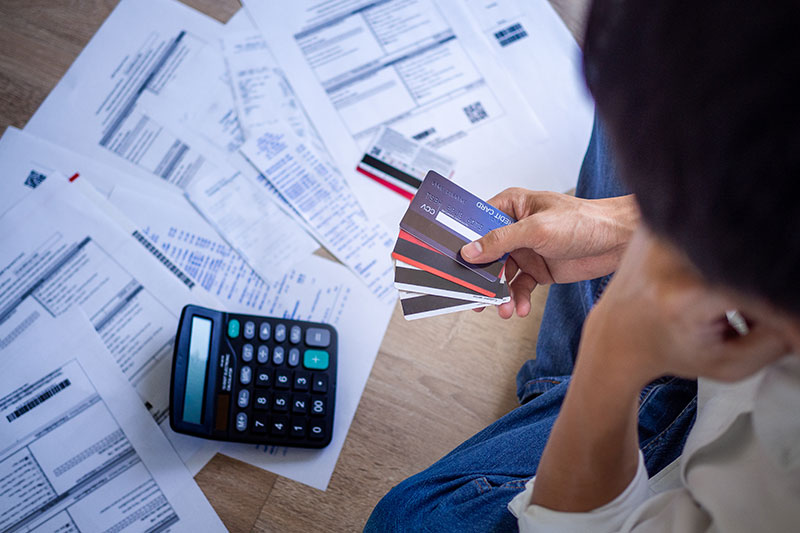If you struggle with credit card debt, you are not alone. In the fourth quarter of 2018, Americans owed a collective $870 billion in credit card debt – a five percent increase from 2017. These staggering figures aside, you may be wondering how you can get your debt under control.
Fortunately, all is not lost: You have options. Here, we share six simple steps to wrangling your credit card debt and regaining command of your financial health.
1. Evaluate your finances
It’s time to get honest with yourself about the numbers. What is your total debt? What about the interest rates on each balance? Simply stated, you cannot commit to debt-free living if you bury your head in the sand. Figure out how much you owe, then craft a plan to pay it back month by month.
In addition to knowing the balance, minimum payment, and payment due date for each credit card, make sure to really understand your interest rates so you can prioritize your payments accordingly. Many borrowers falsely believe that interest is calculated from the balance at the payment due date or the end of the billing period. Instead, interest typically runs from the average daily balance that travels from month to month. Therefore, it may be more effective to make two smaller payments in a month which will reduce the amount of interest owed, as opposed to just making one payment on the due date.
2. Prioritize your spending
In eliminating debt, it is important to make wise spending decisions. Make sure that your budget allocates money to the basics first, like your living expenses, and reserves anything leftover for card payments. While you’re focused on paying down your debt, set your credit cards aside and commit to using cash so as to avoid racking up even heftier balances.
3. Pay off one card at a time
Generally, there are two methods of selecting the credit card to tackle first. You can either prioritize the card with the lowest balance or the card with the highest interest rate. Whichever card you choose, make sure you always pay above the minimum payment to drive down the balance. If you can afford an extra payment, do it.
While the snowball method, or paying off the card with the lowest balance first, may not be the most cost-effective method, it can be satisfying and motivating to eliminate a bill quickly. Once the first card is paid off, you will move on to the card with the next lowest balance.
The avalanche method, or paying off the card with the highest interest rate first, may take longer to see results than with the snowball method; but, focusing on the higher interest cards will help you pay less interest. This way, your money is going to the balance you owe for goods you purchased – and not just going to the credit card company for their service.
For all your credit cards, make sure you always pay at least the minimum payment and pay it on time. However, keep in mind that the balance will only get smaller once you can start paying more than the minimum. Typically, the minimum payment is equal to the amount of interest incurred on the debt.
4. Consider consolidating
Debt consolidation is a great option for consumers with multiple credit cards. Rather than keeping up with multiple payments and interest rates, a consolidation loan gives you one payment with a fixed interest rate, often much lower than the typical credit card interest rates.
When researching your options, make sure to look for the shortest term you can afford. Some consolidation loans offer attractive low interest rates, but lock you into long-term payment schedules. This could lead to paying much more for the balance than if you had stayed with your credit card providers. If a consolidation loan is right for you, make sure to confirm there will not be a penalty for paying off the balance early – especially if the payment schedule offered is long-term.
5. Transfer the balance
It is important to have a realistic budget before making the jump to a different credit card provider. Transferring the balance for an interest-accruing card to one with no interest may be what you need to tackle that debt. However, if you have a card with a high interest rate, transferring the balance to a card with zero-percent APR may be what you need to pay it off.
Many credit cards have introductory offers of zero-percent interest for a limited time, like the first year. Transferring your balance to a card like this could save you money and give you a chance to pay down the balance. Be cautious with these introductory offers, though. These cards may boast zero interest now, but after the promotional period, that rate may skyrocket. If you know you can pay off the balance in full before interest begins accruing on a new card, a balance transfer may be a smart move.
6. Ask for lower interest rates
This one may sound too good to be true, but if you have a decent credit score and an established history with your credit card provider, a simple phone call might do the trick. Contact your credit card company and ask about getting a lower interest rate. Even a one- or two-percent drop could go a long way in saving you money and helping you eliminate that credit card debt.
In some cases, a credit card consolidation loan can help you. This involves combining your various credit card debts into a single amount owed and paying them down month by month. Reach out to a reputable debt relief company to learn more about whether a credit card consolidation loan may be a tool to help you achieve financial freedom.
Getting out of credit card debt does not have to be difficult. Take it one card at a time. In putting together your plan to tackle your debt, do your research. Some courses of action will affect your credit score more than others. The important thing is to focus on paying down the debt and celebrating each zero-balance along the way.


